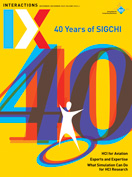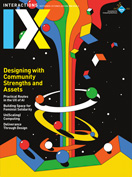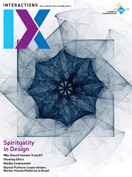Authors:
Luiza de O. Martins
What does it mean to stay with opacity, to reject the impulse toward legibility? What can exist in the crevices, in the in-between spaces of that which we cannot simply measure with our own parameters, or the parameters we were given and taught to value? With opacity, we are confronted with what remains in the corners of our vision, the shifting shadows of ghosts and spirits at the edge of perception; we are called to examine what these shadows can teach us about ourselves and how we engage with the world. Opacity lies at the crossroads of change; it's an invitation to examine our own impulses, that which we are expected to seek, to desire, to yearn for. In this forum, I trace a distinction between conceptions of boundaries and borders through the work of poet and philosopher Édouard Glissant, read through the narratives that cross the digital artwork of interdisciplinary artist Tiare Ribeaux and a documentary film by director and theorist Trinh T. Minh-Ha.
→ This article explores the possibilities of the screen as boundary and as border through theoretical frameworks proposed by poet and philosopher Édouard Glissant
→ This discussion is further developed by looking at the digital artwork of artist Tiare Ribeaux and a documentary film by director and theorist Trinh T. Minh-Ha.
Édouard Glissant was born on the Caribbean island of Martinique. His work explored a wealth of themes and questions on space, identity, and knowledge production. Glissant's fascination with language granted him a remarkable talent for dissecting the particularity of words, their etymology, their history, and the processes that lead us toward expressing something in a specific way. With this also comes an acknowledgment of that which resides in the dark corners of perception, the fugitive nature of which is opaque. Glissant points out that, within the confines of Western thought, the foundation for understanding is a demand for transparency, a process that, in its search for ways of measuring an Other, inevitably leads to their reduction, a simplification of their complexity [1].
Indeed, in discussing the impulse to understand in the sense of apprehending something, Glissant frames the act of "grasping" in relation to the symbolism of enclosure—and perhaps also of individuation, privatization, the act of claiming for oneself a part of the whole. The French word for understanding, he points out, is comprendre—to seize. It is a grasping that can be symbolically linked to the occupation of land: an act of enclosure, a privatization of space that asserts a perceived right to settle and exploit land that should belong to none and all. It can also be linked to the violent touch of harassment: a grasping that negates the humanity of a subject marginalized in the function of gender, race, or ethnicity. Grasping is also a strategy for making an Other readable within the constraints and parameters of white supremacy, heteronormativity, and patriarchy, including taxonomies and classifications that seek to create hierarchies of being where the Other is subsumed to an object to be manipulated in whatever way the aggressor, the harasser, the grasper sees fit—a colonial desire and a capitalist fantasy of invasion and consummation.
Grasping is, in this way, deeply implicated in the foundational act of coloniality: the establishment of the hierarchical racial categories that determine who is granted access to the realm of humanity and who is not. It is a gesture that seeks to determine the hows and the whats of the existence of entire peoples from the removed vantage point of the white gaze, a reduction of complex relations and identities into simplified, discernible bytes, translated into the binaries of hegemonic power. In a conversation with fellow Martinican poet Derek Walcott held at Poets House in 1991, Glissant remarked that the processes that allowed for the emergence of identity in Western cultures "needed a kind of opaqueness…to oppose and reject the other, and to have some écran—screen—between identity and other" [2]. The metaphor of the screen as a divider is particularly poignant here; although at the time the Web was not yet a dominant presence in everyday life, considering these observations during a time when increasing portions of our lives are spent online sharply highlights the continued relevance of Glissant's work to technology studies.
The demand for transparency therefore institutes a frame of separation—a screen designed to display the white subject, determining its contours; a screen into whose confines and parameters all others must now attempt to fit. The existence of this screen is not acknowledged either. The demand for transparency comes with the insidious premise that the parameters it institutes are natural, universally accepted, and transferable—and, therefore, do not need to be examined or discussed. A screen becomes and enforces a border, with whiteness as the simultaneously visible and invisible standard for transparency.
Media theorist Nelly Pinkrah [3], whose research engages with Glissant's ideas within the context of cybernetics, unravels some of these threads further, pointing out that the "cultural logic of the binary that is enforced and materialized through the digital increasingly becomes contested ground, a site to be broken up." She notes that feminist, postmodernist, and poststructural theories have long concerned themselves with the deconstruction of the opposing binaries that sustain hegemonic categories, such as "nature/culture, human/machine, Black/white, master/slave (the latter terminology is used in informatics and software engineering, by the way), and more" [3]. Though Pinkrah believes that the creation of networks that make space for difference and inclusion is possible, she cautions that their emergence hinges on a shifting of power from the individual to the collective—a gesture of letting go that, I would argue, demands a thorough examination of the borders (or screens) separating self and other.
Throughout the past two years, the pandemic has provoked a profound shift in both work and personal interactions. As the world went through successive waves of infection where separation and distance became a necessity in the uneasy struggle to contain pathogens, screens have more than ever gained prominence as key spaces through which questions of uncertainty, boundary-making, and visibility can be explored and performed.
Artist Tiare Ribeaux's two-channel video Pele and Plastiglomerate [4] is a fitting exploration of these themes. It is an art piece meant to be experienced through a screen; in 2020 it was displayed in the virtual exhibition space New Art City, launched during the first wave of the pandemic. Yet Ribeaux's screen feels like skin—as protection, as boundary—more than it does the écran—divider—theorized by Glissant. In the first video, the camera hovers over the 3D-scanned surface of the Kilauea volcano, juxtaposed with chants honoring the volcanic deity Pelehonuamea. Unexpectedly, the camera dives down through the surface, but instead of entering the belly of the earth, we are taken through the scanned skin and into the emptiness of the other side of a virtual model of living earth. There is no lava, the beating pulse of the planet; it is the chanting and Kilauea's crackling sounds that anchor us to the living body of the land.
With opacity, we are confronted with the shifting shadows of ghosts and spirits at the edge of perception.
The second video presents archival footage of Kilauea—melted rock flowing and piling up like the soft folds of a belly. Her lava flows like sap, the thick substance of life that stubbornly spews from the earth among the devastation of coloniality. It melds with the artifacts of contemporary capitalism: bits of plastic and assorted trash, metal chains; it engulfs trees and cars in a steady, slow, unstoppable advance. It surrounds an iPhone, its blank screen absorbed and made into something else, becoming one with the core of the earth. The hardened surface of melted rock advances, wrinkled like the skin of our elders; she is, after all, one of them.
Resonances with Glissant's reflection on the screen as divider can also be found in the work of filmmaker and theorist Trinh T. Minh-Ha. Her short film Reassemblage [5] offers a poignant consideration of the documentary and ethnographic film genre, a practice that seeks to make its subjects graspable by putting them within the context of the screen. Minh-Ha depicts scenes of daily life in rural Senegal, but forgoes the use of the voiceover as an explanatory device. Instead, her narration refuses to describe what the images are showing, focusing on reflections about her own role as an observer with no cultural relation to the societies being depicted. With that, Minh-Ha claims a wish "not to speak about/just speak nearby," an acknowledgment of her presence, her gaze toward another reality that she refuses to explain, to interpret—a refusal to grasp. She describes the practice of speaking nearby as "[a] speaking that reflects on itself and can come very close to a subject without, however, seizing or claiming it."
Key to this conceptualization of speaking nearby is the idea that we can be multiple, one and the other at once, same and different—a profoundly political act embedded in every aspect of life. Speaking nearby describes boundaries rather than borders; while the former flows, the latter divides. Similarly to Minh-Ha, Pinkrah remarks that, for Glissant, "understanding can never be a totality. It is not about getting to the bottom of things, or of someone, to fully comprehend and understand, to fully grasp, all of which entails some sort of violence. The making-transparent" [6]. Concurrent to the enforcement of whiteness as norm, a process of extermination of all subjectivities that do not conform to this rule takes place through ontological, epistemological, economic, and political means, and is materialized in acts of violence and repression. A genocidal push toward the simplification of a complex reality, clearing out entire cultures like unruly pixels on a transparent background.
Glissant's work, in response, demands the right to opacity, the right not to conform to imposed parameters, a mode of "subsistence within an irreducible singularity" [1]. Clamoring for opacity, however, does not imply a nostalgic yearning for a state "untouched" by the forces of colonization, nor can it be animated by an impulse that seeks to maintain a notion of cultural purity—precisely because this assumes a fundamental, binary separation between self and other. As in Minh-Ha's work, Glissant's claim to opacity is positioned nearby, in the provisional, relational space where boundaries and conceptions of collectivity have room to shift and change. As in Ribeaux's video, the claim to opacity allows for encounters within and in relation to difference. The screen, then, takes on a new role: not of a divider, but rather of a flowing boundary, a strategy for understanding subjects in relation to one another.
Glissant's discussion of the act of grasping might, at times, raise more questions than offer answers. These are questions without a definitive ending, that open up and close down and open up again. We are drawn to ask ourselves: Who is allowed to perform these acts of grasping, how, and under what circumstances? How is that grasping articulated through, with, and across difference—both as a way to assert it and as a way to maintain a false notion of unity aimed at understanding the human experience within a hierarchical framework? How are these acts of grasping manifested and perpetuated through the digital technologies and infrastructures that surround us?
In his rejection of this colonial grasping impulse, Glissant offers instead the concept of giving-on-and-with—translator Betsy Wing's version of the French term used by the poet, donner-avec. What would allow us to experience what Glissant suggests as this form of giving-on-and-with? There is a foundational generosity in the idea. A border seizes, closes, ends; a boundary gives-on-and-with, generating other worlds precisely through its ability to make space for living in relation to one another. The generous power of giving-on-and-with is a form of love, a way of being with another while acknowledging the impossibility of completely knowing one another. It approaches love as a practice divested from the impulse for grasping, for owning, for consuming, from the violences of homogenization, classification, and standardization. The forms of generosity and generativity in the works of Glissant, Minh-Ha, and Ribeaux offer key insights for the making of worlds that accommodate complexity, heterogeneity, and difference, worlds where the animacy and subjectivity of all beings—those who are living, as well as those who are not yet or no longer embodied—is recognized and valued. Worlds that are multiple, and where understanding is not the premise for the recognition of relation. Indeed, Glissant astutely remarks:
I say that nothing is true and everything is alive. We've already gone over this—what that means is that nothing is absolutely true. There isn't one absolute truth, but truths. Everything is alive; everything is a Relation of differences, not contraries, but differences [2].
1. Glissant, É. Poetics of Relation. B. Wing, trans. Univ. of Michigan Press, Ann Arbor, 1997.
2. Glissant, É. and Walcott, D. From the archives: Édouard Glissant and Derek Walcott in conversation about the epic. Poets House (blog). Oct.15, 2018; https://poetshouse.org/from-the-archive-edouard-glissant-derek-walcott-in-conversation/
3. Pinkrah, N.Y. The digital has been around for a while. Gunda Werner Institute / Feminism and Gender Democracy. Heinrich-Böll-Stiftung (blog). Feb. 11, 2021; https://www.gwi-boell.de/en/2021/02/11/the-digital-has-been-around-for-a-while
4. Ribeaux, T. Pele and Plastiglomerate. Two-channel video with audio, 3D models, 3D printed sculpture, bioplastics, rocks, digital prints on chiffon; http://www.tiareribeaux.com/peleplastiglo
5. Minh-Ha, T.T., dir. Reassemblage. Documentary, Short, 1983.
6. Pinkrah, N.Y. Weaving fabrics. In The Endotic Reader No.1. L. Sandoval and B. Busch, eds. The Institute for Endotic Research, Berlin, 2019, 63–70.
Luiza Prado de O. Martins is an artist, writer, and researcher whose work examines themes around fertility, reproduction, coloniality, gender, and race. [email protected]
Copyright held by author. Publication rights licensed to ACM.
The Digital Library is published by the Association for Computing Machinery. Copyright © 2022 ACM, Inc.








Post Comment
No Comments Found